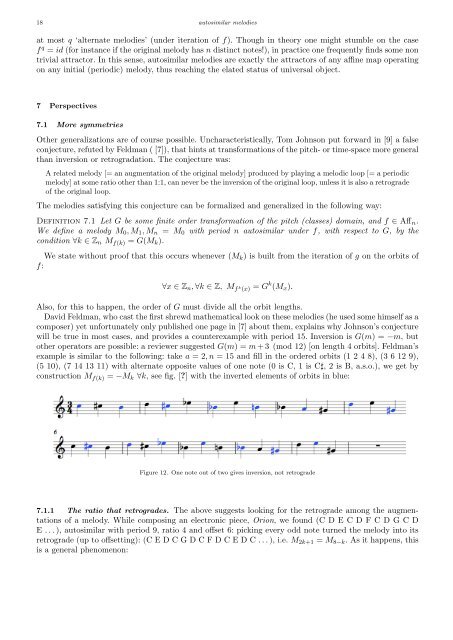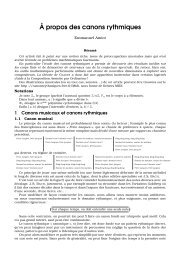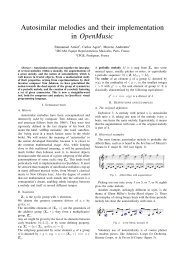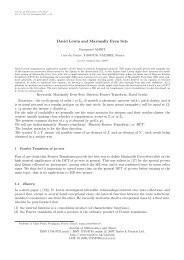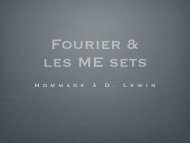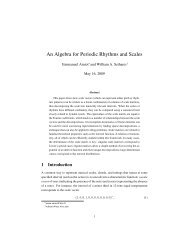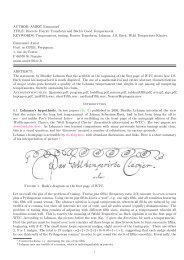Emmanuel Amiot Modèles algébriques et algorithmes pour la ...
Emmanuel Amiot Modèles algébriques et algorithmes pour la ...
Emmanuel Amiot Modèles algébriques et algorithmes pour la ...
You also want an ePaper? Increase the reach of your titles
YUMPU automatically turns print PDFs into web optimized ePapers that Google loves.
18 autosimi<strong>la</strong>r melodies<br />
at most q ‘alternate melodies’ (under iteration of f). Though in theory one might stumble on the case<br />
f q = id (for instance if the original melody has n distinct notes!), in practice one frequently finds some non<br />
trivial attractor. In this sense, autosimi<strong>la</strong>r melodies are exactly the attractors of any affine map operating<br />
on any initial (periodic) melody, thus reaching the e<strong>la</strong>ted status of universal object.<br />
7 Perspectives<br />
7.1 More symm<strong>et</strong>ries<br />
Other generalizations are of course possible. Uncharacteristically, Tom Johnson put forward in [9] a false<br />
conjecture, refuted by Feldman ( [7]), that hints at transformations of the pitch- or time-space more general<br />
than inversion or r<strong>et</strong>rogradation. The conjecture was:<br />
A re<strong>la</strong>ted melody [= an augmentation of the original melody] produced by p<strong>la</strong>ying a melodic loop [= a periodic<br />
melody] at some ratio other than 1:1, can never be the inversion of the original loop, unless it is also a r<strong>et</strong>rograde<br />
of the original loop.<br />
The melodies satisfying this conjecture can be formalized and generalized in the following way:<br />
Definition 7.1 L<strong>et</strong> G be some finite order transformation of the pitch (c<strong>la</strong>sses) domain, and f ∈ Affn.<br />
We define a melody M0, M1, Mn = M0 with period n autosimi<strong>la</strong>r under f, with respect to G, by the<br />
condition ∀k ∈ Zn M f(k) = G(Mk).<br />
We state without proof that this occurs whenever (Mk) is built from the iteration of g on the orbits of<br />
f:<br />
∀x ∈ Zn, ∀k ∈ Z, M f k (x) = G k (Mx).<br />
Also, for this to happen, the order of G must divide all the orbit lengths.<br />
David Feldman, who cast the first shrewd mathematical look on these melodies (he used some himself as a<br />
composer) y<strong>et</strong> unfortunately only published one page in [7] about them, exp<strong>la</strong>ins why Johnson’s conjecture<br />
will be true in most cases, and provides a counterexample with period 15. Inversion is G(m) = −m, but<br />
other operators are possible: a reviewer suggested G(m) = m + 3 (mod 12) [on length 4 orbits]. Feldman’s<br />
example is simi<strong>la</strong>r to the following: take a = 2, n = 15 and fill in the ordered orbits (1 2 4 8), (3 6 12 9),<br />
(5 10), (7 14 13 11) with alternate opposite values of one note (0 is C, 1 is C♯, 2 is B, a.s.o.), we g<strong>et</strong> by<br />
construction M f(k) = −Mk ∀k, see fig. [?] with the inverted elements of orbits in blue:<br />
Figure 12. One note out of two gives inversion, not r<strong>et</strong>rograde<br />
7.1.1 The ratio that r<strong>et</strong>rogrades. The above suggests looking for the r<strong>et</strong>rograde among the augmentations<br />
of a melody. While composing an electronic piece, Orion, we found (C D E C D F C D G C D<br />
E . . . ), autosimi<strong>la</strong>r with period 9, ratio 4 and offs<strong>et</strong> 6: picking every odd note turned the melody into its<br />
r<strong>et</strong>rograde (up to offs<strong>et</strong>ting): (C E D C G D C F D C E D C . . . ), i.e. M2k+1 = M8−k. As it happens, this<br />
is a general phenomenon:


